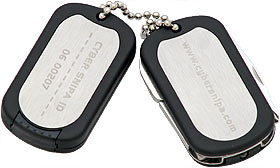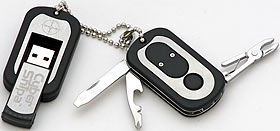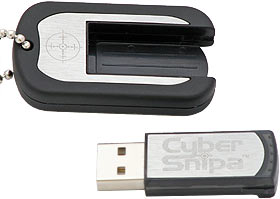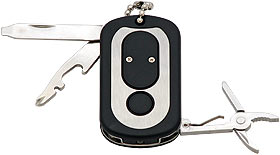
Quick Shot review 34:
Cyber Snipa Dog Tags
Reviewer: Mark CocquioReview date: 27th November 2006. Last modified 03-Dec-2011.
OK, we've had the webcam that looks like a spotting scope, the mouse and mousemats with crosshairs to match. What else could Cyber Snipa come up with to keep the headshot-loving gamer fully accessorised?
Dog tags, of course.
These are more than just a questionably chic fashion accessory.
One tag contains a USB flash drive, while the other houses a small pocket-knifey toolkit and LED torch.
As you can see, they each come with a little chain, typical of nail clippers and... actual dog tags. There's a separate, longer chain included in the package too, so that you can hang one or both of the tags around your neck if you want to go all hardcore bling bling on your LAN mates.
Of the shorter chains on the tags themselves, the USB drive's was slightly longer. I'm not sure if this is cleverly deliberate (an uneven, separate chain on one of your tags in the army aids its removal for identification - thus avoiding the inconvenience of having to carry an entire corpse), but I suspect it may be more to do with the slightly-less-than-military-spec manufacturing processes going on in China (where they're manufactured).
In addition to the long chain, the box also contains a shortish (roughly 70cm/two feet) USB extension cable, and my review unit also came with a driver/utility CD, though the retail ones don't.
The dog tags are just about the same size as their real world namesakes, although with a cross section of around about 9mm they're a fair bit thicker.
The first tag houses a USB flash drive. It's also got a place for you to engrave or stamp your name or 1337 handle. Pro tip: Remove the flash drive and put it somewhere safe before you start grinding and stamping.
When plugged in, the drive is automatically recognised by modern operating systems, and away you go. Recalcitrant Windows 98ers will need to install a separate driver, which Cyber Snipa unfortunately do not currently make available for download. This universal one may work.
The drive has an LED that flashes while it's being accessed, which is helpful for letting you know when it's safe to yank it out (provided, in Windows, you have the driver set for "Quick Removal", as opposed to "Performance").
The Cyber Snipa site seems to convey the impression that the LED is used as a free space indicator too. I'm not quite sure how they decided that, because it's clearly not the case, but it's no biggie. The way it works in the real world is actually more useful.
Speed-wise, the drive managed around 9.6Mb/sec while reading, and 5Mb/sec while writing. This isn't terrible, but it also isn't amazing, and it's nowhere near the theoretical maximum of USB 2.0 (480 megabits per second, which is more than 57 megabytes of data, or maybe 45 megabytes of actual user data, per second).
That said, no currently available flash drive can max out USB 2.0, but many can perform significantly faster than Tag's. For example, the very latest Corsair flash drives claim to be two or three times faster than it.
[Aus PC inform me that they actually write at about the same speed as the Cyber Snipa drives, but read at close to 20 megabytes per second. So twice as fast, yes, but only one way. -Dan]
It's worth noting that performance is also tied to size of the file or files you're transferring. Moving many smaller files onto the drive will take noticeably longer than just transferring one big one, and writing is always slower than reading, mainly because Flash RAM has to be erased in a separate operation before new data can be written to it.
The review sample I received only has a 128Mb flash drive, which isn't even a size Cyber Snipa offer to the general public. Their official range of tags have storage capacities from 512Mb to 4Gb.
Of course, in the usual way of storage capacity fibs, the actual capacity of my review drive is 124Mb - actually slightly more than the usual 1000-based measurements of hard drive manufacturers, but still less than 128Mb. No doubt the larger versions of the flash drive will have a similar skew factor applied to their real-world capacities.
The disc I got has the Win98 driver on it, and also contains a utility called Flash Disk Manager. This fairly simple little application lets you format the drive for use as a boot disk, or as a password-protected, encrypted drive (on Windows systems only). I tried out both of these modes and they worked just fine, without any hiccups.
[But you won't get this CD with retail units, because rather than write their own boot-disk-making software, the OEM responsible for it decided to take a shortcut and simply use MS-DOS utilities without licensing them. They could have used Linux or something and not paid a penny, but since copyright is regarded as an enormous joke in most of Asia - paying for Windows is kind of like paying for bottled water, in their opinion - they didn't see any reason to not take the obvious course. So, as with the bundled software that comes with a variety of other cheap Asian hardware (video players that come loaded with tons of movies, barebones PC systems with the cracked Windows version of your choice preinstalled...), Aus PC Market are required to dispose of the Cyber Snipa discs, lest Microsoft take out a contract upon them. And you can make your Flash drive bootable easily enough anyway - this HP utility will do it for many manufacturers' drives. -Dan]
The flash drive itself also comes with a pre-loaded 30-day trial installer for "Carry it Easy", a synchronisation manager that will let you carry about your essential files, browser bookmarks and so on.
I had a quick look at it, but, as Dan mentions here, your mileage may vary, and there are plenty of free options.
Interestingly, the Multi Tool Flash Drive (as reviewed by Dan) comes from the same factory as the Cyber Snipa tags, and as a result they share various components. I wouldn't be surprised if the USB flash drives are the same internally, and certain parts of the second tag are nearly identical to components of the Multi Tool.
As you can see, the second dog tag is a tiny toolkit, with a white 3mm LED torch, two mini screwdrivers and a weeny pair of pliers. As with the MTFD, there's no cutting implements, so you ought to be able to take the tags on a plane.
(A reader who flies regularly in Australia has now pointed out to me that in his experience Aussie airport security will wisely confiscate pretty much any God-damned thing made of metal from you, definitely including very small screwdrivers and pliers. To coin a phrase: $^&@ing buffoons. On the other hand, AusPC staff going to and from Hong Kong have been OK with these bladeless tools.)
The usefulness of the tools varies. Starting off with the pliers - well, they're really very small. Don't expect to do any power gripping; they're more for removing and replacing fiddly jumpers on hard drives, or for retrieving dropped screws from in between motherboard components. Which they do quite admirably.
So, a small tick there.
Likewise, the torch isn't going to light up your world with the searing blaze of an atomic blast, but it will let you find your keyhole in the dark, or light up the interior of your PC case while you work. Its beam is emitted from the same end of the tag as the pliers, so once again, removing that hard to reach (and see) jumper should be pretty easy going.
The torch is virtually identical to the one built in to the MTFD - it has the same 3mm LED and switch arrangement, and uses the same CR1025 lithium cells.
As Dan mentions, using watch batteries to drive white LEDs is fairly cruel, and indeed a quick test showed that while the initial current flow was about 30mA, it rapidly dropped, and kept dropping. This means that the LED was punishing the batteries quite harshly.
CR1025 batteries are pretty small cells, and, like all batteries of this type, used continuously their life will be short and brutish. Used intermittently though, they should last long enough to cast reasonably strong light for some time. Lithium cells also have an excellent shelf life, so the batteries will still be OK if the torch isn't used for long periods of time.
So, another small tick for the torch.
The other side of the tag houses two screwdrivers. One is a flat blade, with a nail file on the side.
It's almost identical to the flat driver on the MTFD, and hence it's also not the sturdiest of creatures; I wouldn't be surprised to see it break or twist under a heavy load. This limits its usefulness to smaller screws that aren't overly tight, but for those it's just fine.
Likewise, the nail file is good for fingernails, and that's about it. You're not going to be breaking out of a paddywagon with this one, but I doubt it adds much cost to the whole caboodle, so hey, at least you can be the grunt with the nicest manicure at the next LAN party.
The last "blade" on the toolkit is supposedly a Phillips head screwdriver, with a bottle opener on the side. It's certainly a lot sturdier than the flat blade driver, as is necessitated by the bottle opener, and indeed it made short work of opening a tasty beverage to help me with my work.
I wish I could say that the screwdriver was as useful. It's listed on the box as a "star screwdriver". Perhaps they hadn't heard the term "Phillips", but perhaps they deliberately avoided using it - because it's not like any Phillips head screwdriver that I've ever seen.
The basic problem with it is that it's not shaped like a right-angled cross - it's shaped more like an upper case "X"; more of a flattened cross. This makes it completely unusable; I could barely get a loose screw to turn with it. The only thing it's good for, it would seem, is reaming screw heads, or stabbing jumbo jet pilots.
I'm really puzzled as to why this sort of design flaw has made it into production. It seems unlikely that nobody noticed, so perhaps I got a bad one. No other reviewers seem to be complaining about it either, but that is possibly because they didn't try and use it; after all it looks ok at a cursory glance.
The driver in Dan's Multi Tool Flash Drive review looks very similar - I think it's basically just slightly larger version of the part in the Tag.
[And, indeed, the MTFD screwdriver works well enough, though its smooth edges make it less likely to work on really small Phillips screws, unlike the similar-looking Victorinox driver/openers. Aus PC Market have promised to check the drivers on the Tags they sell, and not let them out the door if they're like Mark's review model. -Dan]
Overall
These little tags are certainly unique. They combine a number of handy geek functions in a distinctive package that is sure to appeal to many. They needn't be worn around the neck either; in fact I can imagine that the majority of people will prefer to keep them on a key ring.
So, a recommendation from me basically boils down to the question of value. USB flash drives are a dime a dozen these days, and you will pay a premium for the bling factor and tools offered by these tags.
For people in Australia and New Zealand, Aus PC Market have the 512Mb, 1Gb and 2Gb models, for $AU79.20, $AU101.20 and $AU143 respectively, all including Australian delivery. This works out at roughly $0.15, $0.10 and $0.07 per megabyte.
(Update: Prices have, of course, dropped a lot since this review was new. See the end of this review for updated prices.)
They also sell the Multi Tool Flash Drive, which has all of the same features in a pocket knife shape, plus a pen to boot, for $AU88 (512Mb) and $AU126.50 (1Gb).
(Update: You've missed your chance for that one - AusPC no longer sell that product.)
If all you need is a flash drive, a 1Gb Corsair will set you back $AU66 - so you're paying a premium of $AU22 for the added features of the Dog Tags.
Thinking about it this way, the premiums on the 512Mb and 2Gb tags are $AU27 and a whopping $AU46, respectively.
For $AU46 you can pick yourself up a much nicer toolkit or pocket knife, but of course, it won't look like a dog tag, and it probably won't have a torch built in.
International folks can order a set of tags from the Cyber Snipa online shop here, which also offers the 4Gb model.
The Cyber Snipa tags will definitely make a good stocking filler for your favourite militarised geek this Christmas, but if you're not that taken by the look, perhaps a separate flash drive and pocket knife (or the Multi Tool Flash Drive) are better options. It's up to you.
Buy one!
It's been a while since this review went up, but Aus PC Market
still sell two capacities of Cyber Snipa Dog Tags, much cheaper than when this
review was new.
Australian shoppers can click below to order:
512Mb Cyber Snipa Dog Tags
- $AU27.50 delivered
1Gb Cyber Snipa Dog Tags -
$AU38.50 delivered
Or, for Aussies who would prefer a flash drive without the bling:
Corsair Voyager 16Gb USB 2.0
Flash Drive - $110 delivered
Corsair Voyager
32Gb USB 2.0
Flash Drive - $198 delivered
(The smaller capacities mentioned above are no longer available.)





